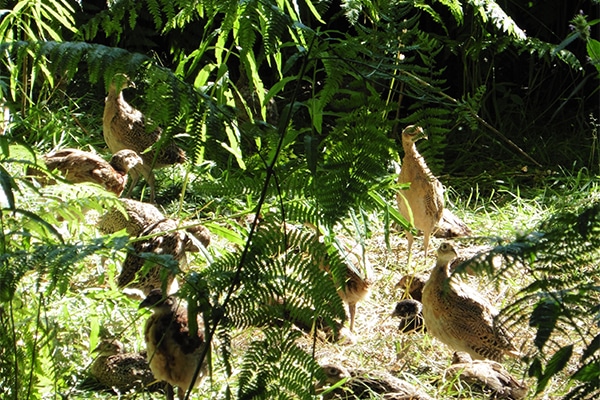
Pheasant release pen
How to create a pheasant pen that meets The Code of Good Shooting Practice’s requirements.
Get information on the legal shooting season for mammals and birds in the UK.
Apply for funding for your project or make a donation today
Comprehensive information and advice from our specialist firearms team.
Everything you need to know about shotgun, rifle and airgun ammunition.
Find our up-to-date information, advice and links to government resources.
Everything you need to know on firearms law and licensing.
All the latest news and advice on general licences and how they affect you.
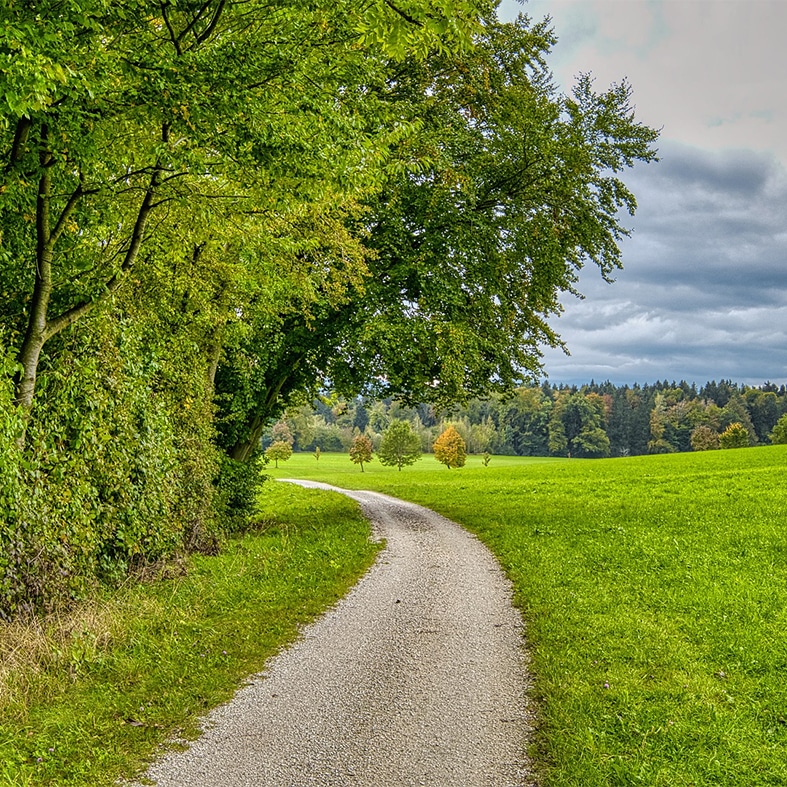

Home » Gamekeeping » Land management » Creating open spaces
Woodlands provide habitats for many quarry species and shooting activities as well as being vital for supporting biodiversity in our landscapes.
Woodlands can be managed to promote both conservation and shooting interests through various techniques.
Creation of open spaces within woodlands is a simple starting point and one of the government’s key indicators for woodland health.
Open spaces within and next to woodlands are areas without trees or shrubs or where trees or shrubs are scattered but do not form a closed canopy.
These can be glades, grassland habitats, rides, paths and tracks, scrubby edges or other open wooded habitat.
Open spaces in woodlands are natural and often temporary occurrences, created when trees fall over, which then fill again as the canopy closes or new trees and shrubs regenerate to fill the gap. The government’s National Forest Inventory indicates a woodland in good condition should comprise 10 to 20 per cent open area, yet many UK woodlands fall well short of this.
However, open areas can be created and maintained through management activities such as tree felling, coppicing and scrub management.
Open spaces within woodlands act as an important habitat for many species. By creating areas where the tree canopy is open, more sunlight can reach the woodland floor.
This allows young trees, plants and insects that struggle to survive in shady areas, or that need different soil and air conditions, to thrive.
These open areas provide alternative growing, foraging and nesting conditions to closed-canopy woodland, and therefore increase the range of wildlife that the woodland can support. Some species require both the closed canopy and the edges provided by open space for different parts of their life cycle.
Open spaces can provide substantial benefits for gamebird release sites, wild gamebirds, flushing points, and deer/wildlife management practices.
In addition, providing vehicle access via rides to woodland glades aids practical woodland management activities and deer extraction.
Pheasants favour woodland edges, as these provide shrubby areas for shelter and roosting. These edges do not need to be on the outside of the wood – the edges of glades and rides provide the same habitat. By creating lots of edges and open spaces using rides and glades, this naturally provides more habitat for released birds to not only shelter but to feed and sun themselves, increasing gamebird retention and health.
Well-positioned release pens (see our guidance on pheasant release pens) can incorporate these open spaces, providing more sunny spots for birds as well as enabling shrubs and plants to recover more quickly.
These scrubby edges and open spaces also benefit woodland birds including woodcock (see our guidance on woodcock) and nightjar.
The amount of open space in woodland can be increased and maintained through management techniques such as thinning, coppicing, cutting new rides, targeted grazing and widening existing rides.
Thinning can dramatically improve the amount of light reaching the forest floor throughout the woodland; however, too much open space can be detrimental to woodland health. Aim for up to 20 percent of your woodland to be made up of open spaces
If you do intend to actively fell any woodland, ensure you seek expert advice and appropriate permissions before commencing any work.
Fallen or felled trees, whether the result of management or natural causes (e.g. storms or death), can create gaps in the tree canopy quickly and effectively. These trees can be left in place and provide lying deadwood, a great haven for wildlife. If you are removing trees, consider allowing the woodland to naturally restock or expand through regeneration rather than re-planting.
Regenerating trees will be well suited to the site and will be a tell-tale sign that you are on top of herbivore management.
Small trees and branches from any thinning can be used within the woodland to create more habitat, rather than be removed. During the winter months, brash and fallen branches can be positioned at the base of standing trees to provide covered nesting sites for gamebirds and protection from aerial predators.
Alternatively, this can be laid as dead hedges on cold woodland edges to provide a windbreak and flushing point, or at intervals throughout the woodland to provide natural holding points for gamebirds.
Brash piles provide valuable habitat for wildlife and, as opposed to burning, carbon is released more slowly from the ‘top and lop’ approach associated with woodland management work.
In woodlands that have limited roosting opportunities for gamebirds due to the age or structure of trees present, fallen branches can be lifted and positioned across the branches of standing trees in sheltered areas of the wood, creating additional safe roosting space.
Rides are open corridors that cut through the woodland to allow access, whereas glades are open patches scattered throughout a woodland. Glades can be isolated areas within the woodland or created at the intersection of rides, or along ride edges – known as ‘scalloping’, often making them easier to maintain.
These open areas can be created within woodland through felling or can be planned before the wood is planted.
On woodland edges, rides can be created by setting back fences and strategically planting shrubs to create scallops. Both glades and rides provide sheltered sunlit areas within woodlands and can host huge numbers of flowering plants and insects as well as the birds and mammals that feed on them.
Glades and rides not only create sunny grassy areas for wildflowers and insects, but provide a great location for a high seat or doe box to help with deer, fox, squirrel and rabbit management.
Gamebirds benefit greatly from sunny glades; they provide an airy, bright space to dry off after wet weather and space for mating and territorial displays.
Rides can also help with gamebird management before and on shoot days, providing clear routes to position feed hoppers or spread feed. They act as ideal flushing points for birds, allow the demarcation of drives within big woodland blocks and also provide areas to line out beaters at the start of a drive. These open glades and rides also offer a location to stand Guns on a woodland drive.
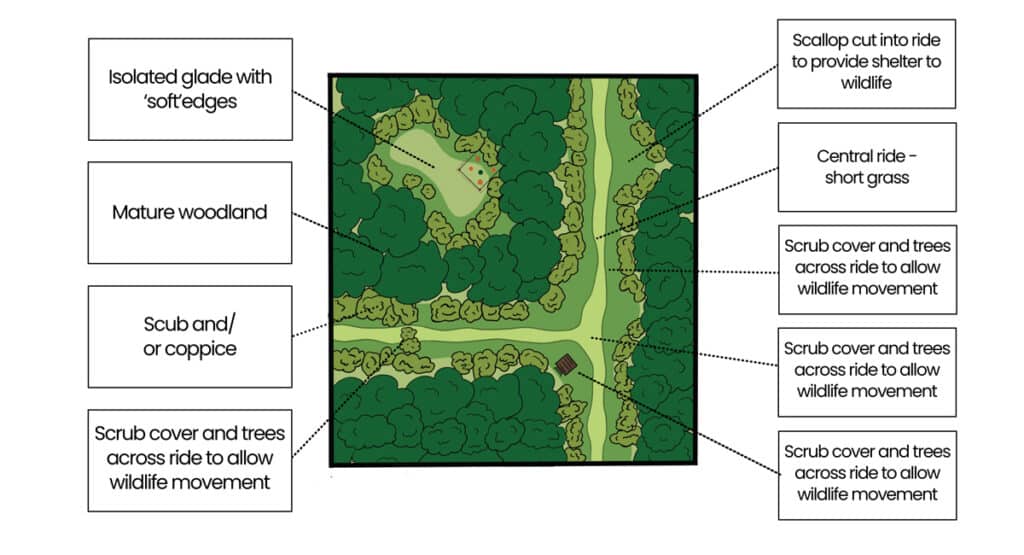
Rides and glades need to be maintained and often widened to prevent them becoming overgrown and shaded.
Mowing and flailing the centre of the ride should be undertaken annually to retain a mixture of short and tall grasses along with some shrubs. Cutting alternate sides of the ride on a two-year rotation will allow a mixture of different vegetation lengths to establish along ride edges, supporting more wildlife.
Cutting back bracken, bramble and nettles can encourage other plants to grow and natural regeneration to occur. To keep rides and glades open permanently, overshading trees may need to be felled on occasion.
Targeted grazing using small numbers of cattle or ponies can be a low cost alternative to mechanical ride management. Their grazing patterns increase the structural diversity of vegetation and their dung supports many invertebrate species. This approach is best used late in the year for short intervals and should avoid using sheep, which cause similar damage to deer.
When creating, widening or managing rides, avoid leaving them open-ended as this can create a wind tunnel and make them less attractive to wildlife.
Try planting hedges, laying dead hedges at the end of the ride, and creating gently curving rides. You could also leave some large trees within the ride to prevent wind funnelling and act as bridges for wildlife to move across open spaces.
Pheasant feed and watering stations are ideally placed along managed rides, which allow for easy access for winter feeding and provide space for birds to scratch and feed. These areas can dry out much faster after rainfall, reducing the survival of parasites.
Regularly move the feeders and water containers to avoid disease and pest infestations and be conscious of placing feed stations where birds could be susceptible to predation.
Adding wavy edges and D-shaped in-shots along rides or on the edges of the wood can provide more areas for shelter in the form of shrubs and thickets for wildlife.
These ‘scallops’ can offer wind protection for gamebirds feeding on rides as well as reduce predation from aerial predators through varied cover and nearby shelter. South-facing scallops will receive the most sunlight and provide sunny spots for long periods during the day.
These scallops can be kept open or coppiced to create young growth and prevent the ride closing up.
Coppicing or pollarding, the periodic cutting back of trees to the ground or stumps, and allowing new stems to sprout from here, is one way of allowing more light to reach the woodland floor and provides extra structure and shelter to your woodland.
Due to the mixed ages and cover that coppicing and pollarding creates, these sections of scrub and thicket are key habitats for wildlife including dormice and woodcock.
The best open spaces should have gradual or ‘soft’ edges, transitioning from grassy areas, to shrubs, to mature trees. This gradual edge provides a variety of woodland structures to support wildlife. Soft edges are also important for gamebird retention, sheltering the internal woodland and providing a variety of tree age-classes for roosting.
These soft edges can even be created by planting scrub at the edge of existing woodland, creating a soft transition between closed canopy woodland and surrounding land use.
If wide enough, this gradual increase in cover height can also allow an optimal 30-degree angle for flushed birds to take off and force them upwards, providing sporting shots.
Allowing space between habitat heights will also provide flushing points which are clear enough for birds to easily take flight. Encouraging low shrubs and game cover at the woodland edges can provide space to collect any running birds, providing them with a final point from which to flush.
Ensure the shrubs you have are native, as opposed to invasive, non-native species such as rhododendron or snowberry.
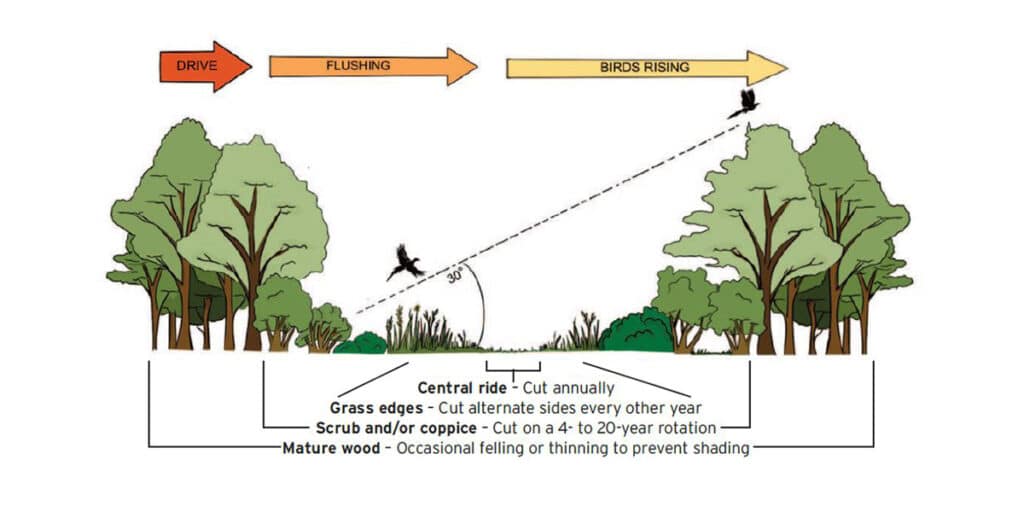
Open areas sometimes exist naturally, where soil lacks the nutrients for tree growth, the ground is too wet, the area is too rocky or there is an established forestry track in place. Instead of giving up on this area, adopt a ‘soft-edge’ approach to this habitat through mowing, coppicing and scrub management.
Areas of naturally wet ground can provide insect-rich feeding areas and benefit many reptile and bird species that depend on soft ground for foraging.
As a rule of thumb, the ride should be at least as wide as the trees in the woodland are high,
to prevent shading.
Coppicing should only be undertaken in 7- to 20-year cycles, dependent on the tree species, to create varied ages of regrowth. Fresh regrowth is very attractive to woodland herbivores and over-browsing can kill the tree stumps, so keep on top of deer and squirrel management in these areas (see our guidance on herbivore damage in woodlands). Piling brash over freshly cut stumps can help to protect regrowth from over-browsing and provides good habitat for insects and nesting birds.
Too much open space can result in fragmented woodland and reduce the shelter available inside the woodland. If your woodland is smaller than 10 hectares (25 acres), creating large open spaces is not recommended and management should focus on improving the soft edges around the outside of the woodland block, or expanding the woodland into surrounding land with a diverse scrubby margin.
You will need to discuss your plans with the landowner and other interested parties, i.e. foresters and farming tenants, and get overall agreement.
You will need a licence and/or consent to carry out many woodland management activities (such as planting, felling and thinning), particularly on designated or protected sites.
When planning any management, ensure you are not disturbing any nesting or hibernating wildlife, many of which are legally protected. The best way to do this is to plan work for late autumn and winter.
Further guidance on woodland management and wildlife
Further guidance on licences, management plans and grant schemes

How to create a pheasant pen that meets The Code of Good Shooting Practice’s requirements.

If your shoot has five or more employees at any one time it is a legal requirement to have a health and safety policy in place.
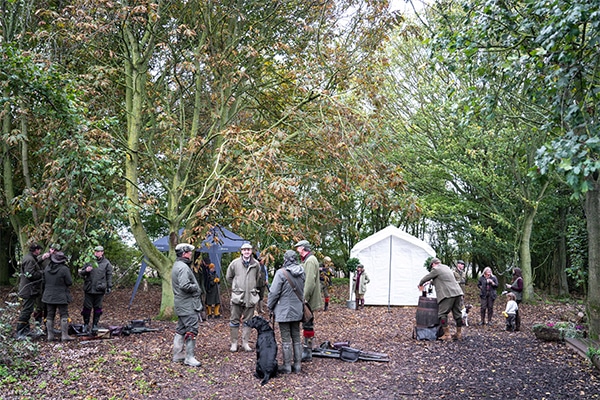
Where shooting clubs and syndicates are concerned there is no definitive answer to the question ‘Do we have to register under the General Data Protection Regulations (GDPR)?
Sign up to our weekly newsletter and get all the latest updates straight to your inbox.
© 2025 British Association for Shooting and Conservation. Registered Office: Marford Mill, Rossett, Wrexham, LL12 0HL – Registered Society No: 28488R. BASC is a trading name of the British Association for Shooting and Conservation Limited which is authorised and regulated by the Financial Conduct Authority (FCA) under firm reference number 311937.
BASC Direct Ltd is an Introducer Appointed Representative of Agria Pet Insurance Ltd who administer the insurance and is authorised and regulated by the Financial Conduct Authority, Financial Services Register Number 496160. Agria Pet Insurance is registered and incorporated in England and Wales with registered number 04258783. Registered office: First Floor, Blue Leanie, Walton Street, Aylesbury, Buckinghamshire, HP21 7QW. Agria insurance policies are underwritten by Agria Försäkring.
If you have any questions or complaints about your BASC membership insurance cover, please email us. More information about resolving complaints can be found on the FCA website or on the EU ODR platform.